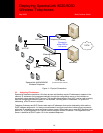
Deploying SpectraLink 8020/8030
Wireless Telephones
May 2009 Best Practices Guide
When operating with an IP telephony server (IP PBX), other than Avaya or Cisco, the SVP Server also
requires a range of IP addresses that cover the total number of wireless telephones supported by that SVP
Server. That range of IP addresses is known as First Alias IP Address/Last Alias IP Address in the SVP
Server configuration menu. It is important to note that for redundancy purposes it may be necessary to
assign more IP addresses to an SVP’s Alias IP range than what the SVP Server would normally support.
Each SVP Server supports up to 500 handsets registered, but this can be limited by the total number of
Alias IP addresses configured in the SVP Server.
When a handset is using SVP and registers with the telephony server, one of the IP addresses within this
range is used to communicate between the SVP Server and the telephony server. This IP address is used
by the SVP Server as an alias to communicate with the telephony server on the wireless telephone’s behalf,
but will not be equivalent to the handset’s IP address that was either statically assigned or obtained from the
DHCP server. The range of alias IP addresses must not be used within any DHCP range or cover the IP
address used by any other device. In the case where multiple SVP Servers are used for added capacity or
redundancy, an exclusive range of IP addresses equivalent to the number of total users each SVP Server
supports is required per SVP Server. All alias IP addresses must be within the same IP subnet as the IP
address of the SVP Server they are assigned to.
3.3 Software Updates Using TFTP
All SpectraLink infrastructure components are field-upgradeable in terms of new software features and bug
fixes. SpectraLink handsets utilize a TFTP client to automatically download new code when available.
Deployments using Telephony Gateways to connect to a traditional PBX have an integrated TFTP server to
support Wireless Telephone and OAI Gateway software upgrades. However, the integrated TFTP cannot
be used to deliver software to the e340/h340/i640 wireless telephones. A network TFTP server will
simultaneously update multiple handsets, while the Telephony Gateway can only update handsets one at a
time. Therefore, in larger systems and newer deployments, a separate TFTP server should be used rather
than using the Telephony Gateway’s TFTP capability. For deployments with multiple Telephony Gateways it
is recommended to utilize an external TFTP server to centralize the management and delivery of software.
The SVP Server also requires a TFTP server for software updates. The Telephony Gateway cannot be used
as a TFTP server for the SVP Server code. Telephony Gateways receive software updates only through
FTP updates. The OAI Gateways can receive software updates via FTP as well but if software recovery
becomes necessary the OAI will utilize a TFTP server. Software updates
are available from Polycom’s web
site.
17
©2009 Polycom, Inc. All rights reserved.
Polycom and the Polycom logo are registered trademarks of Polycom, Inc. All other trademarks are the property of Polycom, Inc. or their respective companies.


















